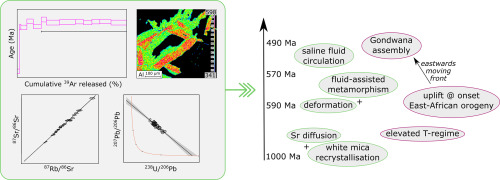当前位置:
X-MOL 学术
›
Gondwana Res.
›
论文详情
Our official English website, www.x-mol.net, welcomes your feedback! (Note: you will need to create a separate account there.)
Geochronology of metamorphism, deformation and fluid circulation: a comparison between Rb-Sr and Ar-Ar phyllosilicate and U-Pb apatite systematics in the Karagwe-Ankole Belt (Central Africa)
Gondwana Research ( IF 6.1 ) Pub Date : 2020-07-01 , DOI: 10.1016/j.gr.2020.02.008 Johanna Van Daele , Stijn Dewaele , Frank Melcher , Peter Onuk , Richard Spikings , Stijn Glorie , Gilby Jepson , Philippe Muchez
Gondwana Research ( IF 6.1 ) Pub Date : 2020-07-01 , DOI: 10.1016/j.gr.2020.02.008 Johanna Van Daele , Stijn Dewaele , Frank Melcher , Peter Onuk , Richard Spikings , Stijn Glorie , Gilby Jepson , Philippe Muchez

|
Abstract This work presents an integrated geochronology study combining step-heating Ar-Ar and in-situ Rb-Sr phyllosilicate geochronology with EPMA elemental maps and U-Pb apatite geochronology in order to determine the timing and duration of regional deformation and fluid circulation processes in the Karagwe-Ankole Belt in Central Africa. The Kibuye-Gitarama-Gatumba study area (West Rwanda) forms part of the Western Domain of this Mesoproterozoic belt, where the metamorphic and deformation history, geothermometric evolution and mineralization processes (both genesis and geochronology) have been well-documented in previous studies. Our geochronological results and interpretations show the importance of thermal diffusion throughout the elevated temperature regime present in the Neoproterozoic. During the Ediacaran, metamorphism and fluid alteration in the Gatumba area was associated with deformation, as independently demonstrated by U-Pb apatite and Ar-Ar phyllosilicate geochronology. From the end of the Ediacaran until the Late Cambrian, saline fluid activity is recorded and fluid-induced (re)crystallization processes dominate the Gatumba biotite isotope record. The direct comparison between and Ar-Ar geochronology suggests a parentless 40Ar-component is preserved during this fluid-induced (re)crystallization due to its saline, (earth) alkali-rich composition. Additionally, this multi-method approach allows us to place the history of the Western Domain of the Karagwe-Ankole belt in relation to that of the surrounding areas, i.e. the Eastern Domain and the Congo and Tanzania Cratons. Deformation and epidote-amphibolite facies metamorphism (at ~590–570 Ma), and fluid fluxes (at ~590–495 Ma) occurred in the Kibuye-Gitarama-Gatumba area after the West Gondwana Orogeny but from the onset of the East African Orogeny onwards till after the culmination of the Gondwana amalgamation, demonstrating the progressively eastward-moving orogenic front in this supercontinent assembly.
中文翻译:

变质作用、变形和流体循环的年代学:Karagwe-Ankole 带(中非)Rb-Sr 和 Ar-Ar 层状硅酸盐和 U-Pb 磷灰石系统的比较
摘要 本工作提出了一项综合地质年代学研究,将逐步加热的 Ar-Ar 和原位 Rb-Sr 层状硅酸盐年代学与 EPMA 元素图和 U-Pb 磷灰石年代学相结合,以确定区域变形和流体循环过程的时间和持续时间。中非的卡拉格韦-安科勒带。Kibuye-Gitarama-Gatumba 研究区(西卢旺达)是该中元古代带西部领域的一部分,在先前的研究中,变质和变形历史、地温演化和成矿过程(成因和地质年代学)已得到充分记录。我们的地质年代学结果和解释表明,热扩散在整个新元古代存在的高温区域中具有重要意义。在埃迪卡拉纪期间,加通巴地区的变质作用和流体蚀变与变形有关,U-Pb 磷灰石和 Ar-Ar 层状硅酸盐地质年代学独立证明了这一点。从埃迪卡拉纪末期到晚寒武纪,记录了咸水流体活动,流体诱导(重)结晶过程主导了加通巴黑云母同位素记录。和 Ar-Ar 地质年代学之间的直接比较表明,由于其富含盐水、(地球)碱的成分,在这种流体诱导(重)结晶过程中保留了无母体 40Ar 组分。此外,这种多方法方法使我们能够将 Karagwe-Ankole 带西域的历史与周边地区(即东域以及刚果和坦桑尼亚克拉通)的历史联系起来。变形和绿帘石-角闪岩相变质作用(约 590-570 Ma),
更新日期:2020-07-01
中文翻译:

变质作用、变形和流体循环的年代学:Karagwe-Ankole 带(中非)Rb-Sr 和 Ar-Ar 层状硅酸盐和 U-Pb 磷灰石系统的比较
摘要 本工作提出了一项综合地质年代学研究,将逐步加热的 Ar-Ar 和原位 Rb-Sr 层状硅酸盐年代学与 EPMA 元素图和 U-Pb 磷灰石年代学相结合,以确定区域变形和流体循环过程的时间和持续时间。中非的卡拉格韦-安科勒带。Kibuye-Gitarama-Gatumba 研究区(西卢旺达)是该中元古代带西部领域的一部分,在先前的研究中,变质和变形历史、地温演化和成矿过程(成因和地质年代学)已得到充分记录。我们的地质年代学结果和解释表明,热扩散在整个新元古代存在的高温区域中具有重要意义。在埃迪卡拉纪期间,加通巴地区的变质作用和流体蚀变与变形有关,U-Pb 磷灰石和 Ar-Ar 层状硅酸盐地质年代学独立证明了这一点。从埃迪卡拉纪末期到晚寒武纪,记录了咸水流体活动,流体诱导(重)结晶过程主导了加通巴黑云母同位素记录。和 Ar-Ar 地质年代学之间的直接比较表明,由于其富含盐水、(地球)碱的成分,在这种流体诱导(重)结晶过程中保留了无母体 40Ar 组分。此外,这种多方法方法使我们能够将 Karagwe-Ankole 带西域的历史与周边地区(即东域以及刚果和坦桑尼亚克拉通)的历史联系起来。变形和绿帘石-角闪岩相变质作用(约 590-570 Ma),



























 京公网安备 11010802027423号
京公网安备 11010802027423号